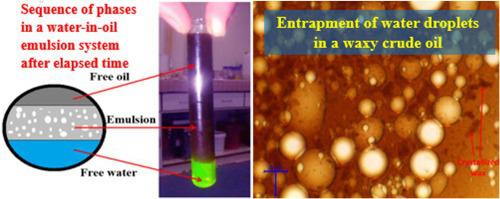当前位置:
X-MOL 学术
›
Colloids Surf. A Physicochem. Eng. Aspects
›
论文详情
Our official English website, www.x-mol.net, welcomes your feedback! (Note: you will need to create a separate account there.)
A mechanistic understanding of the water-in-heavy oil emulsion viscosity variation: effect of asphaltene and wax migration
Colloids and Surfaces A: Physicochemical and Engineering Aspects ( IF 5.2 ) Pub Date : 2021-01-01 , DOI: 10.1016/j.colsurfa.2020.125604 Ali Piroozian , Mahmoud Hemmati , Mehdi Safari , Ali Rahimi , Omeid Rahmani , Shahram M. Aminpour , Amin Beiranvand Pour
Colloids and Surfaces A: Physicochemical and Engineering Aspects ( IF 5.2 ) Pub Date : 2021-01-01 , DOI: 10.1016/j.colsurfa.2020.125604 Ali Piroozian , Mahmoud Hemmati , Mehdi Safari , Ali Rahimi , Omeid Rahmani , Shahram M. Aminpour , Amin Beiranvand Pour

|
Abstract The role of emulsions as a prevalent phenomenon is broadly investigated in the petroleum industry since forming the emulsion has many severe harmful implications. Heavy components of crude oil such as wax and asphaltene make the water-in-oil (w/o) emulsion more stable, while the role of these components on the emulsion viscosity has not been fully understood. In this regard, to find a proper demulsifier to break these emulsions, it is necessary to know the mechanisms of emulsion formation by heavy oil components. In this study, the effects of waxy-oil and asphaltenic-oil on w/o emulsion were investigated by measuring volume and viscosity of the formed emulsion after an elapsed time, followed by proposing a viscosity model based on experimental data. For this purpose, two types of crude oil were used: asphaltenic oil and waxy oil. Next, the emulsion stability and phase separation in these samples were studied, and viscosity for each segment was measured and modeled in the system. Results showed that phase separation and emulsion formation depend on the presence of asphaltenic-oil and waxy-oil after the passage of a specific time such that the system exhibits a strong function of asphaltene rather than wax. Also, free oil volume decreased with increasing water cut to 70%, where most declines occurred at a stirring rate of 1200 rpm in the presence of asphaltene. Besides, the viscosity of the free oil decreased with increasing water cut to 70% in both waxy-oil and asphaltenic-oil systems such that the free oil viscosity decreased from 11.43 cp to 5.89 cp when the water cut increased from 0% to 70%. Findings also showed that the viscosity of the w/o emulsion phase decreased with increasing the shear rate and temperature, resulting in increased stability in the emulsion. Based on a proposed viscosity model, the model results showed a dispersed oil-in-water (D O/W) flow for the highest water cut of 70% with an average deviation of 7.03% and revealed an accurate estimation to the experimental data. The model approach can be applied in the estimation of the water-in-heavy oil emulsion viscosity in pipelines.
中文翻译:

重油包水乳液粘度变化的机理理解:沥青质和蜡迁移的影响
摘要 乳液作为一种普遍现象在石油工业中被广泛研究,因为形成乳液具有许多严重的有害影响。原油中的蜡和沥青质等重质组分使油包水(w/o)乳液更加稳定,而这些组分对乳液粘度的作用尚未完全了解。在这方面,要找到合适的破乳剂来打破这些乳液,有必要了解重油组分形成乳液的机制。在本研究中,通过测量一段时间后形成的乳液的体积和粘度,研究蜡质油和沥青质油对 w/o 乳液的影响,然后根据实验数据提出粘度模型。为此,使用了两种原油:沥青质油和蜡质油。下一个,研究了这些样品中的乳液稳定性和相分离,并在系统中测量和模拟了每个部分的粘度。结果表明,相分离和乳液形成取决于经过特定时间后沥青质油和蜡质油的存在,使得该体系表现出强烈的沥青质而不是蜡的作用。此外,自由油体积随着含水率增加到 70% 而下降,其中大部分下降发生在沥青质存在下 1200 rpm 的搅拌速率下。此外,在蜡质油和沥青质油体系中,游离油的粘度随着含水率增加到 70% 而降低,使得当含水率从 0% 增加到 70% 时,游离油的粘度从 11.43 cp 下降到 5.89 cp . 研究结果还表明,w/o 乳液相的粘度随着剪切速率和温度的增加而降低,从而提高了乳液的稳定性。基于提出的粘度模型,该模型结果显示,最高含水率为 70% 时,分散水包油 (DO/W) 流的平均偏差为 7.03%,并揭示了对实验数据的准确估计。该模型方法可用于估计管道中重油乳化液粘度。
更新日期:2021-01-01
中文翻译:

重油包水乳液粘度变化的机理理解:沥青质和蜡迁移的影响
摘要 乳液作为一种普遍现象在石油工业中被广泛研究,因为形成乳液具有许多严重的有害影响。原油中的蜡和沥青质等重质组分使油包水(w/o)乳液更加稳定,而这些组分对乳液粘度的作用尚未完全了解。在这方面,要找到合适的破乳剂来打破这些乳液,有必要了解重油组分形成乳液的机制。在本研究中,通过测量一段时间后形成的乳液的体积和粘度,研究蜡质油和沥青质油对 w/o 乳液的影响,然后根据实验数据提出粘度模型。为此,使用了两种原油:沥青质油和蜡质油。下一个,研究了这些样品中的乳液稳定性和相分离,并在系统中测量和模拟了每个部分的粘度。结果表明,相分离和乳液形成取决于经过特定时间后沥青质油和蜡质油的存在,使得该体系表现出强烈的沥青质而不是蜡的作用。此外,自由油体积随着含水率增加到 70% 而下降,其中大部分下降发生在沥青质存在下 1200 rpm 的搅拌速率下。此外,在蜡质油和沥青质油体系中,游离油的粘度随着含水率增加到 70% 而降低,使得当含水率从 0% 增加到 70% 时,游离油的粘度从 11.43 cp 下降到 5.89 cp . 研究结果还表明,w/o 乳液相的粘度随着剪切速率和温度的增加而降低,从而提高了乳液的稳定性。基于提出的粘度模型,该模型结果显示,最高含水率为 70% 时,分散水包油 (DO/W) 流的平均偏差为 7.03%,并揭示了对实验数据的准确估计。该模型方法可用于估计管道中重油乳化液粘度。



























 京公网安备 11010802027423号
京公网安备 11010802027423号